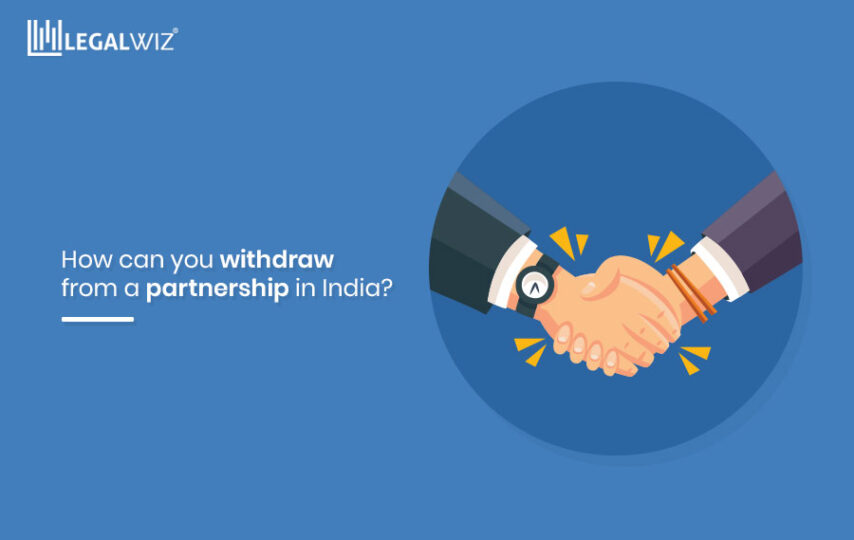Launching a business in the market is exciting. But as time goes on, things do not seem as well as we expected them to. Any of the associates, voluntarily or involuntarily, might decide to leave or withdraw from the partnership in India.
That’s why all the associates in the partnership should make a business plan on a smooth exit route. It would assist all the stakeholders in avoiding legal intricacies or possible disputes that are caused after the online partnership firm registration. It is crucial to conduct an online partnership firm registration process in India before beginning your business.
Here in this blog, we will discuss how you can withdraw from a partnership in India.
Defining Partnership and Partnership Firm
Two or more individuals can form a partnership firm by an oral or written agreement in India. Partnership firms are regulated and governed by the provisions stated in the Indian partnership act, 1932. Section 4 of the said act clarifies a partnership as the relation betwixt two or more individuals. Vide this relationship, they give the nod to share the business profits run by all or any of the partners.
A partnership firm is the predominant form of business formation in India.
The annual compliance burden of the registered partnership firms is less than other LLPs. There is no requirement for a partnership firm to appoint an auditor as well. If the firm is going through the registration process, it must not submit annual accounts with RoC. Also, a partnership firm is not obliged to submit service tax, sales tax, and taxes relying on the business’s turnover.
Types by which a partner can withdraw from a partnership.
There are two types by which a partner can withdraw from a partnership;
- Voluntary withdrawal of partnership – here, a partner gives personal reasons (such as lack of motivation or retirement) to withdraw from the partnership. Also, he/she provides a nod to give in his/her share of business voluntarily.
- Non-voluntary withdrawal of partnership – for any reason, a partner is obliged to withdraw his/her partnership in the business; it is known as non-voluntary withdrawal. The withdrawal of partnership occurs without the concerned partner’s consent. Such a scenario arises on the occasion of the partner’s demise, when he/she becomes incapacitated or if he/she has been incarcerated for a crime. Other such instances of involuntary withdrawal might include bankruptcy, critical illness, or breach of trust or partnership duties.
Points to keep in mind while deciding how to withdraw from a partnership.
Make a withdrawal letter or notice.
The intricacies of a partnership withdrawal process rely on factors like size, structure, and business success.
In a scenario of a general partnership business, the partners partake in regular business operations. They are also combinedly accountable for debts occurring in the business. In such a business, you can simply write a withdrawal partnership letter if you intend to withdraw your partnership. This letter would serve as a notice of intimation to your other associates concerning your impending exit. This notice would mention the date from which your withdrawal will be implemented.
Thoroughly check your partnership agreement.
Some partnerships involve abstract assets. In such cases, you must review the partnership deed or agreement and check out your options while withdrawing from the partnership. If required, there is a procedure to change partnership deed that help addressing the issues concerning dissolution, withdrawal and transfer of interest. Before preparing a withdrawal plan, one should check the withdrawal provisions mentioned in the agreement thoroughly.
It might signal a prohibition period before the expiry of which no partner can withdraw. It might also state a time frame within which one needs to serve an advance notice concerning their partners’ withdrawal. If you breach such terms stated in the agreement, you might invite financial liability against any resulting damages caused to your associates or the business as a whole.
Dispersing profits and business assets.
A crucial part of the partnership process’s withdrawal is the proper dispersal of profits and business assets after a partner departs. Terms of such distribution are generally stated in the partnership deed or agreement.
If the partnership is not dissolved after a partner withdraws, the assets can be dispersed according to the profit and loss ratios stated in the agreement. It can also be distributed according to the partners’ initial capital contributions to the business (named as their individual capital accounts).
If the business is not dissolved on the partner’s departure, the partner can determine to sell his/her shares to the existing partners. The remaining partners might also opt to assign his/her interest to any third-party partner.







